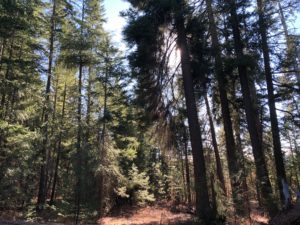Fire Resilience In Our Forests
Columbia Land Trust is managing forestland for the realities of climate change and catastrophic wildfire
The vanilla scent of ponderosa pine mingles with dust in the air as a crew of Land Trust staff and interns convene in the forest near Washington’s Summit Creek, a tributary of the Klickitat River. Contractors from Slawson Wood Products out of Goldendale have been on site since 6:00 a.m. and were just packing up their chainsaws by late morning to mitigate fire risk. Together, the combined crew set into the forest to pile a vast tangle of just-cut logs and branches.
Columbia Land Trust’s July acquisition of 4,900 acres may have marked the culmination of more than a decade of work to establish the nearly 11,000-acre Klickitat Canyon Conservation Area, but in reality, our work is just beginning. Natural Area Manager Lindsay Cornelius has seen her portfolio of stewarded lands in the Klickitat River watershed grow by 340 percent as a result of the recent conservation success at the canyon. In a year of crises, she is taking the new challenge in stride.
“I am energized by this landscape,” Cornelius says, “because there’s so much to learn and discover, because it is so biologically rich, so remote, and so beautiful. And yet there are still many restoration and stewardship opportunities that feel relevant and urgent, never more so than in the wake of this summer’s firestorms.”
Cornelius recognized that the forested portions of the Klickitat Canyon Conservation Area fit into a broader landscape of forestland spanning areas managed in conservation by the Yakama Nation, Mount Adams Resource Stewards, and the Washington Department of Natural Resources (DNR) Natural Areas program. She is exploring the possibility of a collaborative forest-health project with these neighbors and DNR’s Forest Health Program as a funding partner, which could set the course toward a more climate-resilient landscape.
Much of the Klickitat River area’s forests are prone to lightning strikes, fuel loads are elevated, and in many places forest composition has shifted toward Douglas-fir and away from more fire-tolerant species. In addition, a majority of the forest is young, dense, and brushy. In other words, these forests are at risk of burning hotter, longer, and more intensely than they would have historically through a natural cycle of fire and regeneration.
At the Summit Creek project site, mistletoe infestations and overstocked, fuel-laden forests shade out Oregon white oak trees and create fuel ladders into an old-growth stand of ponderosa pine and Douglas-fir on the adjacent Yakama Nation Indian Reservation. A wildfire here would almost certainly have catastrophic effects, compromising the old-growth trees.
Globally, the climate is changing, and in the Northwest, hotter, longer, drier summers along with frequent extreme weather events, including high winds, demand swift adaptation in our work on three fronts: First, we are accelerating the pace and scale at which we conserve Northwest forests, which serve as some of the most effective carbon sinks in the world. Next, we are adapting our forest management plans to further emphasize fire resilience, especially in the East Cascades, both by thinning trees and reducing fuel loads to limit the intensity of fires when they occur, and through prescribed burns that perform the historic role of natural fire in the region’s ecology. Lastly, we are advocating and educating around opportunities for natural climate solutions in the region.
Back at Summit Creek, the day’s work undertaken by Cornelius, Stewardship Assistant Sanoe Keliinoi, and Green Jobs interns Ahmed Yusuf and Jonathan Albarran involves piling the small trees and branches cut by the contractors for later burning. This removes fuels that could otherwise feed wildfires, smother understory vegetation, or contribute to lethal temperatures during a future prescribed fire.

Working early in the morning, father-and-son contractors Rick and Richard Slawson, and their helper Tim, thinned a dense pocket of forest, guided by flags tied by DNR foresters, Keliinoi, and Cornelius. The layout process isn’t entirely linear, or entirely random. When wildfires burn, they can burn in patches, leaving seed sources and cover for wildlife. The goal when mimicking these positive effects of fire is to create not a barren landscape in the understory of the forest but a mosaic brushy skips, which are brushy, and gaps, which are clearings. Birds, including flammulated owls and Lewis’s woodpeckers, benefit from having these breaks in the canopy to access tree cavities and food. The crews also removed conifers from around native Oregon white oak trees to give them more light.
Once the contractors complete thinning efforts across 95 acres of forest along Summit Creek this fall, the Land Trust will look to conduct subsequent phases of forest restoration in adjacent stands, which will involve similarly treating hundreds more acres in preparation for prescribed burns on the property.
“I feel this huge sense of responsibility,” Keliinoi says. “There’s a reconnection between us and the land, change you can literally see once the stands aren’t cloaked in shadows and dead branches anymore. It’s a little overwhelming how much acreage is out here, but I’m excited to be part of the project.”
Throughout the day, the crew members strain their muscles lugging logs and dragging slash across the landscape. In this moment in history shrouded by unrest—as we face climate change, deep social divisions, and a pandemic—this forestry effort in the wilds of Klickitat Canyon offers an experiment in hope. Land managers ranging widely in age, experience, and background traverse common ground together, hewing a flourishing, resilient vision for the future, one tree at a time.